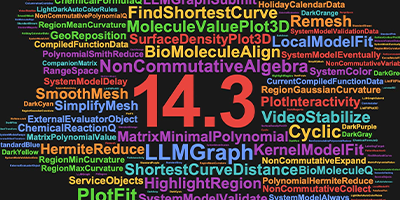Using Mathematica Enterprise Edition to Create Professional Apps, Tools, and Reports
For more than two decades, Mathematica users have been using our technology to solve some of their most difficult problems. And when they find solutions, they need to communicate them to managers, colleagues, and clients.
Like many other organizations, we also need to effectively communicate concepts when we design new technologies, and we need to make decisions quickly and efficiently. In the past, our own technology lacked a means of distributing results that could be viewed with a free document player, in which users could enter their own data, and that could update interactively and in real time.
We made great strides in addressing all of those issues with the introduction of the Computable Document Format (CDF). CDF is a computation-powered knowledge container that supports all sorts of applications, dashboards, and reports.

However, the CDF file format is limited in the way that it can carry and convey information. It wasn’t a viable solution for users who wanted to control how their work was redistributed, or who wanted to import and export data or connect to databases. We needed a way for Mathematica users to create CDFs that could link and interact with proprietary data sources, respond to arbitrary user input, and generate automated results in formats that the rest of their organizations might need, such as PDF, JPG, XLSX, or even new CDFs.
And that’s why Mathematica Enterprise Edition may be one of the most important changes to the way organizations generate and use reports, applications, and tools.
Enterprise Edition allows you to create EnterpriseCDF files, which provide enhanced capabilities that can be deployed via the free Wolfram CDF Player. But what are these capabilities, and why are they important to the work that you do? Let’s take a look.
First, Enterprise Edition allows you to encrypt your code, so recipients cannot see your proprietary algorithms. For consultants and application developers, this was an absolute must. With Enterprise Edition, you can deliver reports, updates, and full solutions to your potential customers without revealing your intellectual property.
Second, EnterpriseCDF files allows users to access and plug in proprietary data, such as Excel spreadsheets, imported images, database files, or even web-based data. When you develop for external customers or clients, we know that you may not always have full access to the data they want to run with your application or report. Enterprise licensing lets you design the analytic reports and tools your customers need, but gives them the flexibility to load in their own data.

In contrast to generic CDF documents, EnterpriseCDF documents can contain input fields that accept arbitrary user input. Users can enter anything from textual responses and comments to custom images to full symbolic expressions. You no longer have to build every variable and parameter into your analyses, visualizations, and computations. You can create templates that users complete with their own data.

Lastly, EnterpriseCDF files can be saved with user data and exported to a variety of supported file formats. For management and customers alike, the ability to interact with a document, make changes that update in real time, and then export the results as customized reports or files (e.g. JPG, PDF, TXT, XLSX, CDF) is a tremendous asset. And the creation of CDF files can be automated, so these interactive reports and tools can easily be updated for viewing on a web page or sent directly to someone’s inbox.
So, how have we used this technology to our own benefit? Well, we create a variety of internal tools, such as the dashboard linked below. This interface visualizes the data constantly updating as people sign up for our virtual conferences, online seminars, and other web-based events. Having a resource like this allows management to get updated information and make decisions in real time about presentation topics, hosting logistics, and future planning.

We also support our Enterprise license holders with 24/7 support and priority technical support by email and phone to assist with production-level issues. We know that timing can be critical to the success of a project, production rollout, or delivery of your solution, and technical service options for project design, code optimization, and additional help are available. In addition, each license comes with 16 computation kernels to meet increased needs for parallel computing across an equivalent number of cores.
Gone are the days when the best solution was dealing with static reports, limited spreadsheets, or word processing documents that required three separate programs to produce images, figures, and tables. None of these formats provide the breadth and interactive flexibility that come with using the combination of Wolfram technologies we’ve assembled through today’s CDF file format, Enterprise Edition, and Mathematica.
If you would like the ability to provide interactive reports, real-time updates, and flexible solutions to your list of managers, colleagues, and clients, contact the Enterprise team for more information on incorporating Mathematica Enterprise Edition into your projects.



Comments
1 comment